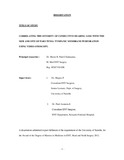| dc.contributor.author | Meera, Patel C | |
| dc.date.accessioned | 2013-02-12T14:44:17Z | |
| dc.date.available | 2013-02-12T14:44:17Z | |
| dc.date.issued | 2012 | |
| dc.identifier.uri | http://erepository.uonbi.ac.ke:8080/xmlui/handle/123456789/8299 | |
| dc.description.abstract | Background: Pars tensa tympanic membrane perforations are associated with a varying degree of conductive hearing loss which is dependent on variables like size and site. In Kenya, use of video-otoscopy is limited thus the description of size and site of the perforations is subjective.
Objective: To determine the correlation of degree of conductive hearing loss with the size and site of the pars tensa tympanic membrane perforations using video-otoscopy at the Kenyatta National hospital.
Study Design: This was a prospective descriptive study.
Materials and methods: The study was carried out in the ENT department of the Kenyatta National Hospital from April 2011 to January 2012. Video otoscope 426/MP was used to take photographs of the perforations. Dino capture 2.0 version 1.3.2.was used to calculate the perforation area. Pure tone audiometry was carried out and results were analysed.
Data analysis: Data was tabulated into customized Microsoft Office Access 2007 database proformas. Stata V11.2.was used to carry out the analysis and included the ANOVA, Kruskwal- Wallis, Pearson's chi square and linear regression methods.
Results: A total of 80 ears were included with an equal sex distribution and a median age of 14.5 years. The commonest cause of perforation was chronic otitis media (84%). The overall mean percentage perforation size was 31.35%. Kruskwal-Wallis test: p=0.0001 demonstrated a significant correlation between site of perforation and hearing loss.Anteroinferior perforations had an average of 26 dBHL and posteroinferior. perforations had an average of ~ 44.3dBHL of hearing loss. The larger the perforation the greater the hearing loss. Posterior perforations
Conclusion: Variables such as the size and site are important aspects in affecting the degree and those that have a posterior component had a higher hearing threshold. | en_US |
| dc.language.iso | en_US | en_US |
| dc.publisher | University of Nairobi, Kenya | en_US |
| dc.title | Correlating the severity of conductive hearing loss with the size and site of pars tensa tympanic membrane perforation using video-otoscopy | en_US |
| dc.title.alternative | Thesis (M.Med.) | en_US |
| dc.type | Thesis | en_US |

